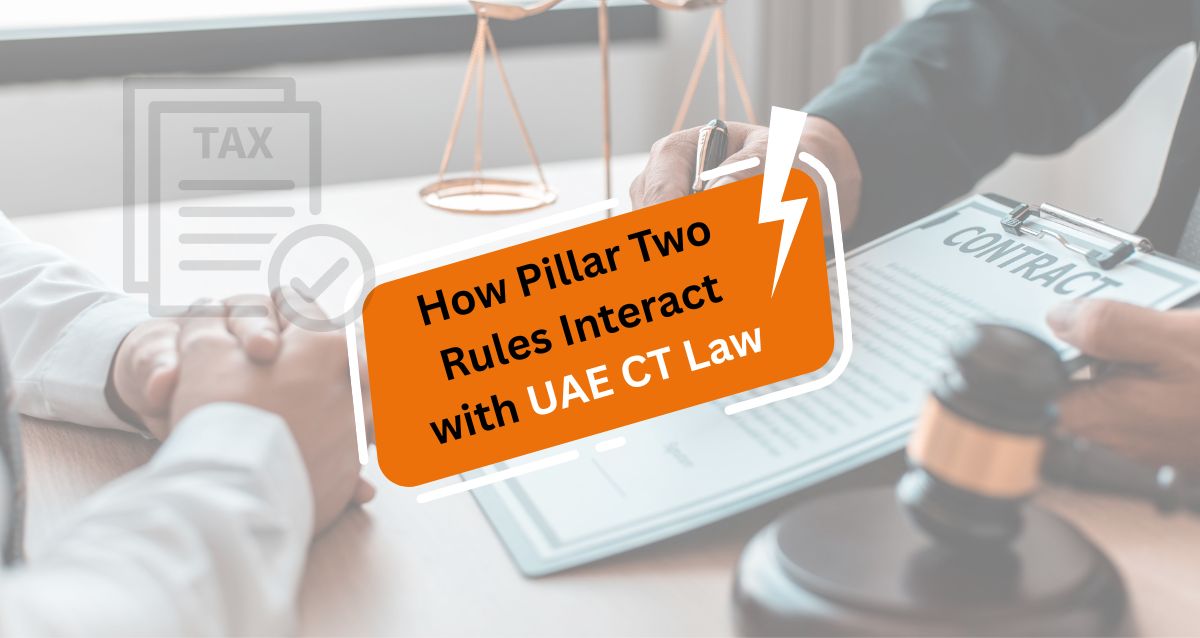Global Minimum Tax Meets UAE CT: How Pillar Two Rules Interact with UAE Corporate Tax Law
Disclaimer: This blog is for informational purposes only and does not constitute tax or legal advice. Businesses should consult a qualified advisor for specific guidance based on their facts.
In a historic move to align with the framework of OECD’s Pillar Two global minimum tax, the UAE introduced the Domestic Minimum Top-up Tax (DMTT) in Cabinet Decision No. 142 of 2024. This complements the Federal Decree-Law No. 47 of 2022 on UAE Corporate Tax, creating a double-layer tax compliance environment for entities which are part of large multinational groups.
It is now critical for those businesses operating in the UAE, especially those which are part of large MNE Groups with global revenues exceeding EUR 750 million, to understand how the UAE Corporate Tax Law and the Pillar Two DMTT regime interact and overlap to avoid tax leakage, penalties, or compliance mistakes.
Understanding the Two Regimes: UAE CT vs. DMTT
|
|
|
|
How the Two Regimes Interact
While both the UAE Corporate Tax and DMTT relate to the taxation of corporate profits, they are different in purpose and application. However, in many ways they are overlapping
1. CT Paid Is Credited Towards DMTT
Any Corporate tax paid in the UAE by an MNE Group Entity is considered as “Covered Tax” under the DMTT provisions and will be included in the effective tax rate (ETR) calculation for the UAE.
Example:
If a mainland LLC earns AED 10M as their taxable income, paid AED 900K (i.e. 9% under UAE CT), this will be counted towards the 15% minimum tax required under DMTT rules. The Top-Up Tax may then only be 6% (i.e. AED 600K more).
2. Free Zone Incentives Trigger DMTT Exposure
Many Free Zone companies, which are classified as Qualifying Free Zone Persons (QFZPs) and enjoy the benefit of 0% UAE CT is perfectly valid under Decree-Law No. 47. However, under Pillar Two rules, these tax benefits are not considered in calculating global Effective Tax Rate.
Therefore, even if the UAE Corporate Tax law says “0% Tax”, Pillar Two rules will still impose a 15% Top-Up Tax, via the DMTT, if the UAE Group’s ETR falls short.
3. Taxpayer Classifications Differ
- Under UAE CT, all companies must register for CT, but not all are taxable.
- Under DMTT, only UAE Constituent Entities which are part of MNE Groups are included. And it will be applicable, even if they are exempt or QFZPs under the UAE CT law.
Tip: A company might have no liability under UAE CT law, but still be fully liable under DMTT.
4. Two Separate Filing Regimes
UAE Corporate Tax returns are filed via the Emara Tax Portal and following local accounting adjustments.
DMTT returns (filing details to be expected soon) will require:
- Profit calculations on a Jurisdiction basis under OECD’s GloBE Income model
- Computation of Effective Tax Rate
- Allocation of Top-Up Tax across constituent entities
Tip: Be prepared for dual reporting and dual documentation starting from Financial Year 2025.
Practical Scenarios for UAE Groups
Scenario 1: Free Zone IP Holding Entity
- QFZP earns AED 40M as revenue from licensing IP to global group companies
- Pays 0% Corporate Tax under UAE laws
- Group Effective Tax Rate in the UAE is 0%
- Under DMTT rules, the entity is liable to pay 15% on AED 40M i.e. AED 6M as Top-Up Tax
Scenario 2: Mixed Mainland and Free Zone Entities
- Mainland company earns AED 10M. Pays AED 900K as per UAE CT law
- Free Zone company earns AED 10M. Pays AED 0 under UAE CT law
- Combined UAE profit is AED 20M
- Combined tax paid is AED 900K
- Effective tax rate is 4.5% (i.e. AED 900K/AED 20M *100)
- Top-Up Tax required is AED 2.1M (i.e. 10.5% on AED 20M)
Scenario 3: No DMTT Due
- UAE Group, forming part of an MNE’s pays full 9% Corporate Tax
- Additionally, they paid 6% Top-Up Tax voluntarily to align with global rules
- Then ETR will be 15%
- No further DMTT liability will arise
- UAE avoids foreign Income Inclusion Rule (IIR) taxation
Key Terms Compared
|
Term |
Under UAE CT Law |
Under DMTT (Pillar Two) |
|
Taxable Person |
Applicable to any businesses with UAE-sourced income |
Applicable only to MNE group entities in the UAE |
|
Covered Tax |
UAE Corporate Tax payable as per Article 3 |
Includes UAE Corporate Tax and equivalent taxes |
|
Income Basis |
Accounting profit plus Adjustments |
GloBE Income as per OECD model |
|
Safe Harbors |
0% Corporate Tax for QFZPs |
Temporary transitional reliefs only |
|
Group Threshold |
None |
EUR 750M plus Consolidated revenue |
Important Considerations for CFOs & Tax Directors
1. Map Entity Structure
➣ Identify which UAE entities fall within the scope of DMTT and calculate their applicable ETRs.
2. Align TP & Profit Allocation
➣ Ensure intercompany transactions are properly documented and priced, which will impact both CT and DMTT calculations.
3. Track Deferred Taxes
➣ Under Pillar Two, timing differences and deferred tax assets can influence GloBE calculations.
4 . Prepare for Dual Compliance
➣ Maintain the reports on reconciliations between UAE CT filings and DMTT disclosures.
5. Coordinate with Global Pillar Two Strategy
➣ Your UAE tax planning must be commensurate with what the Head Quarter files under GloBE rules.
How Flyingcolour Tax Consultant Can Help?
At Flyingcolour Tax Consultant, we guide UAE businesses through:
- Integrated UAE CT + DMTT compliance planning
- Guides in preparing effective tax rate models
- Ensuring Free Zone strategies are properly aligned with DMTT Rules
- Coordinating with HQ teams on Global Pillar Two implementation
- Preparing dual filing systems for 2025 and beyond
To learn more about How Pillar Two Rules Interact with UAE CT Law, book a free consultation with one of the Flyingcolour team advisors.
Disclaimer: The information provided in this blog is based on our understanding of current tax laws and regulations. It is intended for general informational purposes only and does not constitute professional tax advice, consultation, or representation. The author and publisher are not responsible for any errors or omissions, or for any actions taken based on the information contained in this blog.


